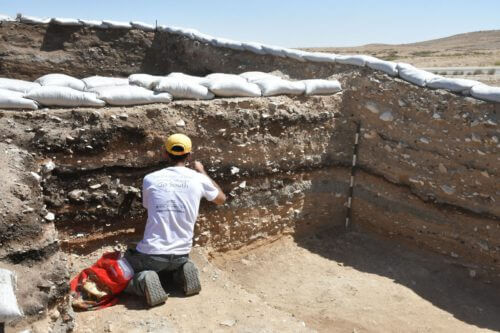The inhabitants of the Byzantine Negev used sheep droppings to fertilize the green fields. With the transition to the Islamic period and the beginning of the collapse of the Negev cities, the sheep's dung is piled up in the barns in such large quantities that it is necessary to burn them

Another secret of the Byzantine agriculture in the Negev of 1500 years ago has been revealed: the inhabitants of the Byzantine Negev used sheep droppings, while properly managing their garbage, to fertilize the green fields. With the transition to the Islamic period and the beginning of the collapse of the Negev cities, sheep dung is no longer used for fertilization and is piled up in heaps in such large quantities that it is necessary to burn them. This is according to a new study carried out at the University of Haifa together with researchers from the Antiquities Authority and published in the journal PLoS ONE, which reveals additional, microscopic evidence, from which the phenomenon of the rise and fall of the Negev cities becomes clear.
Halutza, Shebta, Nitsana and Abdat were part of the Negev cities that flourished starting from the fourth century in the Byzantine period, relying on green and prosperous agriculture in the hot and dry Negev. However, with the transition to the Islamic period, in the seventh century, these settlements began to sink and were finally abandoned in the tenth century. The decline of the Byzantine settlements of the Negev has occupied researchers a lot over the years. The various explanations refer to the political change of transition from Byzantine to Islamic control, climatic changes and economic changes that can explain the sunset. In recent years, Prof. Guy Bar Oz from the Zinman Institute at the University of Haifa has been leading a series of studies that attempt to trace the processes and causes, with the focus of the research being a new general approach: examining garbage piles located on the outskirts of settlements, rather than traditional digging inside the settlements.
In the previous studies, the researchers focused on macroscopic findings - that is, those that can be seen with the eye - such as animal bones and plant remains that formed the economic basis of the Negev residents. The remains of the plant document the extent of agricultural activity that reached its peak in the Byzantine period with the establishment of the wine production branch and its decline in the early Islamic period. These and other findings testified to intensive agricultural activity in the Byzantine period as opposed to limited agriculture in the Islamic period.
Now, for the first time, the researchers have also decided to check microscopic findings found in the dirt that makes up the garbage piles. To their surprise, the researchers found that there was a significant difference in the materials that made up the dirt in the ashrams between the Byzantine and early Islamic periods. In the first period, mainly waste of construction materials such as mortar and stones and residues related to everyday life such as ash from cooking and baking ovens, bones, pottery, and more were thrown away. In the second period it was found that the dirt consists mainly of farm animal dung that has undergone weathering processes so that their characteristic shape has been lost and now they look like dirt. "Apparently, in the Byzantine period, dung was an important commodity that was used to fertilize the agricultural fields, while in the early Islamic period, this source of fertilizer was used less and less, so it was necessary to throw its excess into the garbage piles," said Prof. Ruth Shakh-Gross from the Department of Maritime Civilizations and the School of Marine Sciences at the University Haifa, one of the research leaders.
"We have a number of laboratory methods with which we can identify remains of dung that have decomposed over time, the first of which is the identification of microscopic spherules that are formed in the intestines of animals, mainly in sheep and goats, and since they are composed of inorganic material, they are preserved in archaeological sites even when all the organic material decomposes." Prof. Shakh-Gross explained. In addition, the researchers identified evidence of a fire at the garbage site from the early Islamic period in an examination using the infrared spectroscopy method. "To the best of our knowledge, this is the first time we have identified the management of an ancient garbage site. In our understanding, such large excesses of dung accumulated in the early Islamic period, due to the decrease in agricultural activity in the fields and the increase in grazing activity, that it was necessary to deal with the excess garbage, and this was done by burning it. We are witnessing a huge perceptual change regarding dung in both periods, from a valuable commodity as an important source of fertilizer for agriculture to a useless nuisance that is thrown into the trash and burned there," added Prof. Shakh-Gross.
"The picture that emerges is that in both periods there is planning and management of resources in a sustainable manner, so that while in the Byzantine period the population was based on an economic adaptation that was mainly agriculture combined with herds, in the early Islamic period the population went through a process of adaptation to an economy based on herds, the expression of which is excess dung in the garbage piles from the period The last one", Prof. Guy Bar Oz concluded.
More of the topic in Hayadan:
- An impressive monastery from the Byzantine period with a magnificent mosaic floor was uncovered at the entrance to the settlement of Hora in the northern Negev
- Israeli researchers discovered evidence of the collapse of a commercial vine branch in the Negev 1500 years ago, during a time of plague and climate change
- The rodent bones tell the story of the flourishing Negev 1,500 years ago

One response
Where the Muslims sowed grass no longer grew there